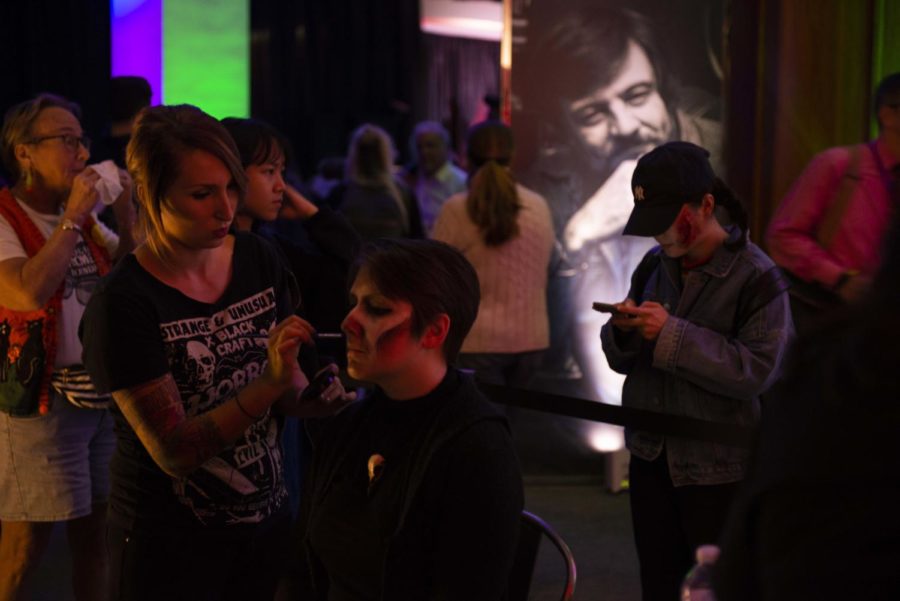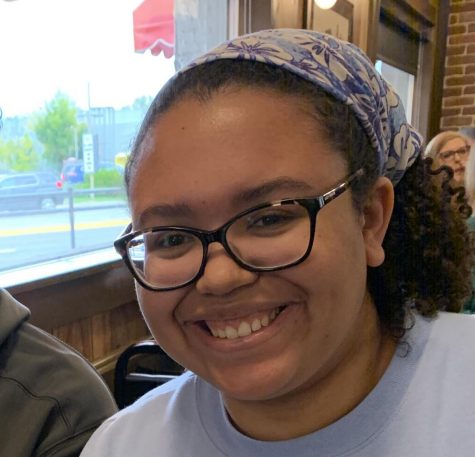George A. Romero Collection brings the dead to life
Collection Wu Caiyi | Staff Photographer
Visitors at Living with the Dead: A Party Celebrating the George A. Romero Archival receive makeup courtesy of ScareHouse.
October 24, 2019
The undead strolled through the dimly lit first floor of the Hillman Library Wednesday night — past the grave of Nicholas Kramer, which Barbara (Judith O’Dea) clung to in after the first zombie attack in the 1968 film “Night of the Living Dead.”
The festivities were part of the University Library System’s celebration of the new George A. Romero Archival Collection recently acquired by the University. Romero, who passed away in 2017, is known as the “Father of the Zombie Film” and created “Night of the Living Dead,” which was filmed in Pittsburgh. The archive is comprised of three separate collections belonging to Romero’s widow, Suzanne Desrocher-Romero, his daughter, Tina Romero, and his friend and former business partner, Peter Grunwald.
At the event, actors read of some of Romero’s screenplays, guests were served zombie-themed snacks and activities like face painting and a trivia challenge were set up around the first floor.
The Romero collection seeks to amass materials and facilitate the scholarly analysis of the horror genre. Ben Rubin, horror stories collection coordinator and curator for the Romero collection, said the collection consists of not only materials from the movie “Night of the Living Dead” — which arguably started the modern zombie genre — but its promotion as well.
“It has a very rich amount of material from unproduced scripts, produced scripts, production materials like cast lists, shooting schedules, location scouting reports, contracts, a lot of publicity and promotional material, sort of like what went into how to promote movies back then, but then also the type of publicity that it was receiving while they were coming out,” he said.
Some of these materials were on display at the event, including an early draft of the screenplay for “Night Of The Living Dead” with annotations, the shooting script for “The Crazies” (1973) and promotional materials for the film “The Amusement Park” (1974).
There was also material from Romero projects that never made it to film, such as “Nuns From Outer Space,” and sketches and notes from 1976 about a Bigfoot film that would have starred Steelers’ running back Franco Harris, who Romero would later make a documentary about. Rubin said he felt the exhibit functions as a learning tool for Pitt students to study film.
“You can see and trace this process of how Romero actually made a film, from an original draft to then watching a final film,” he said. “You can see how it got there, learning from these production materials what goes into scouting, what goes into a contract. All this will really illuminate what that process looks like.”
At the event, William “Chilly Billy” Cardille was posthumously awarded the first annual George A. Romero Foundation Pioneer Award. Cardille hosted local television channel WIIC’s “Chiller Theater” during its run from 1964 to 1983, during which he raised money for Romero’s “Night of The Living Dead.” Cardille also played a field reporter in the film which, according to Romero, would not have been made without Cardille.
Throughout the evening, there were readings from the screenplays of three of Romero’s projects, “Night of The Living Dead,” “Dracula” and “Masque of the Red Death,” the latter two of which were never completed.
“Night of the Living Dead” is widely regarded as a turning point from classic Universal Horror — which refers to the shared cinematic universe coming out of Universal Studios from the 1920’s to the 1950’s — to the more modern version of the genre. Elizabeth Kurtzman, a Ph.D. student studying horror and theater, said she was excited to learn about Romero’s influence on horror filmmaking.
“I’m interested in the performance of fear, so kind of looking at the way that, especially Americans, have a relationship with different genres of horror and why and the politics, and what different things have scared people throughout the ages,” she said.
Mayor Bill Peduto’s signed 2018 proclamation naming Oct. 1 “George Romero Day” was also on display. Pittsburgh played a large role in Romero’s films, as many of them were set here. Courtney Colligan, a Ph.D. student in theater and performing arts, was one of the actors who read from Romero’s screenplays. She said Pittsburgh’s presence is felt throughout much of his work.
“Romero very much works Pittsburgh into his films and his work, and it very much shows,” she said. “In ‘Night of the Living Dead’ he mentions Pittsburgh directly in the opening scene.”
Sean Cook, a graduate student in the Pitt theater department and Colligan’s co-reader, also said Romero made Pittsburgh more than just a setting in his work.
“I’d think that Romero was generous in his use of Pittsburgh. Pittsburgh sort of became not just a location, but almost a character in several of his pieces and audiences came to know that and expect that from his work,” he said.
The addition of the George A. Romero Archival Collection opens new opportunities to film students. Cook said that it was a useful resource for aspiring filmmakers.
“I think having this close connection to Romero, someone who was so prolific will only be a resource for the students in the film studies, and by proxy the theater art students who end up acting in their shows, acting in their movies and acting in their digital series.”









